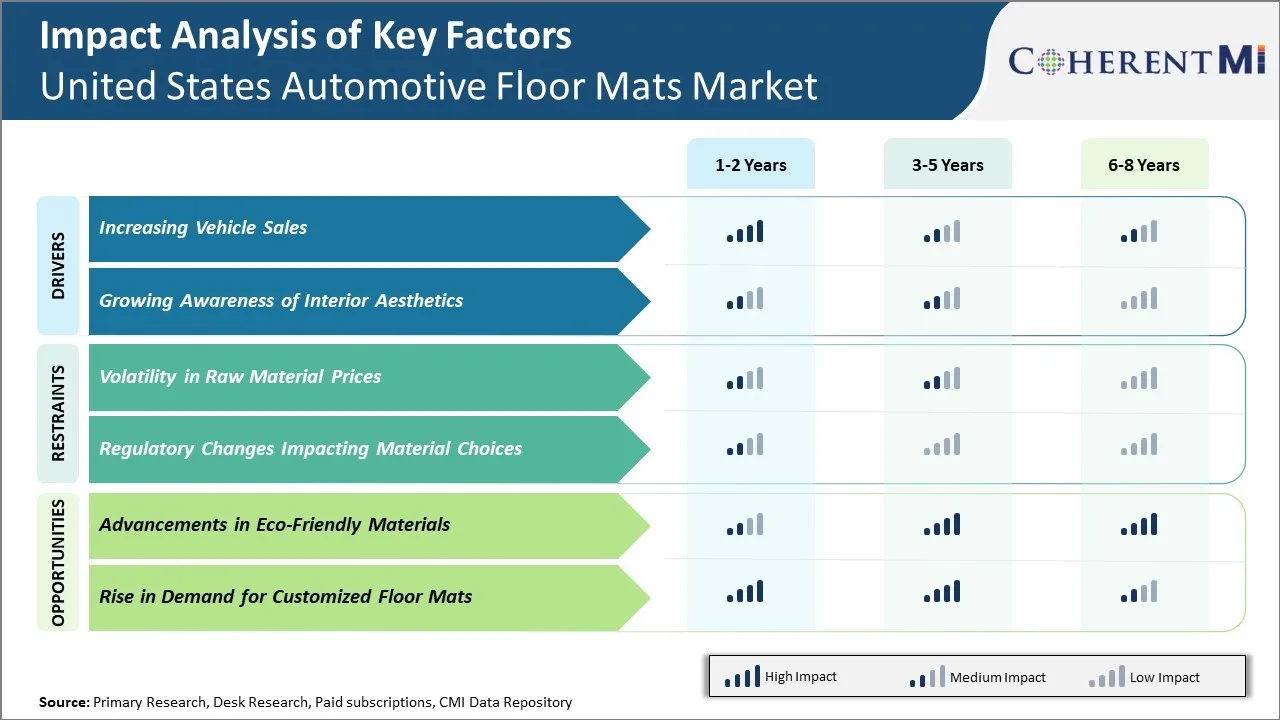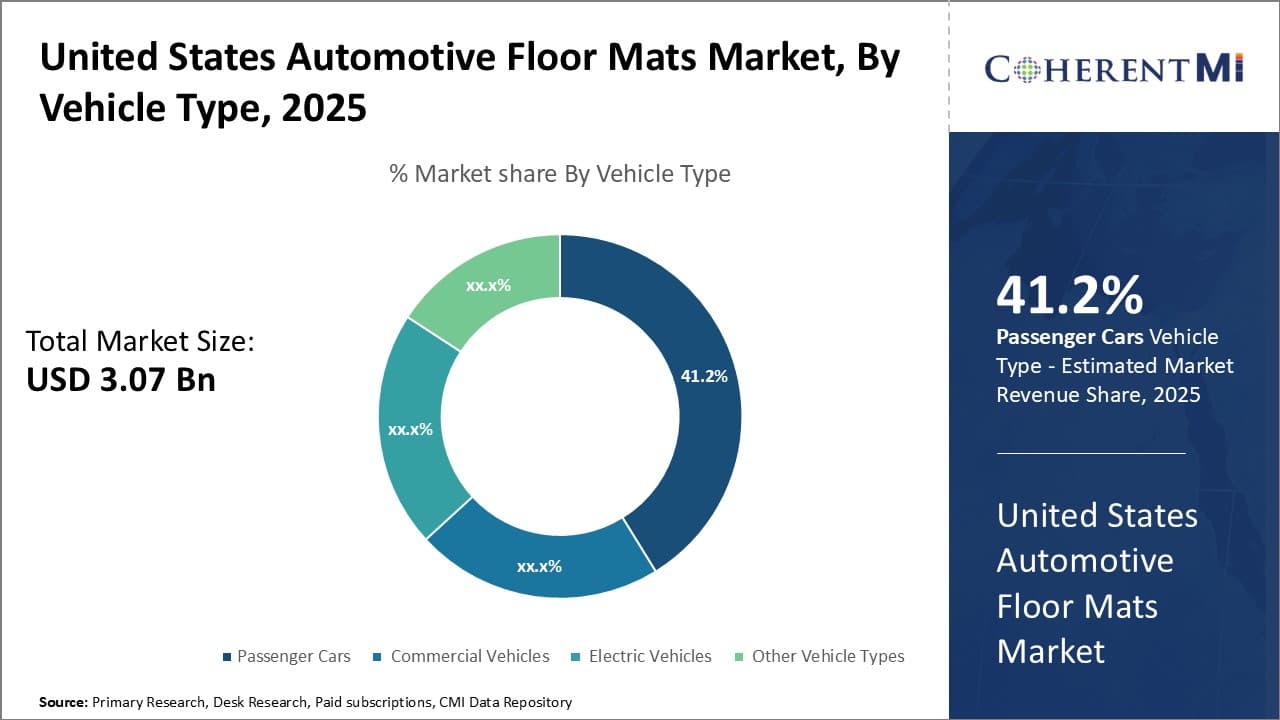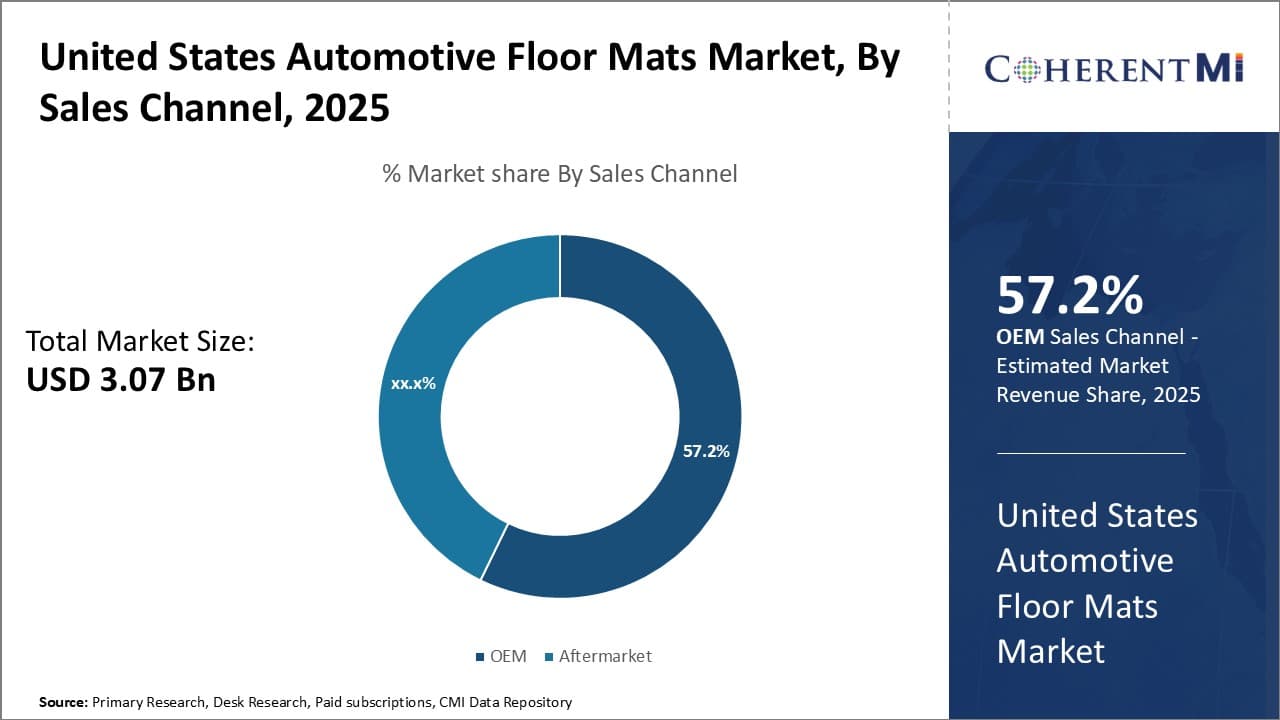

The United States Automotive Floor Mats Market is estimated to be valued at USD 3.07 Bn in 2025 and is expected to reach USD 4.62 Bn by 2032, growing at a CAGR of 6.00% from 2025 to 2032.
Growing demand for premium and luxury vehicles which majorly include carpets and floor mats will remain the key growth determinant for the market.
Market Size in USD Bn
CAGR6.00%
| Study Period | 2025-2032 |
| Base Year of Estimation | 2024 |
| CAGR | 6.00% |
| Market Concentration | High |
| Major Players | WeatherTech, Husky Liners, Lloyd Mats, MAXLINER, Smartliner USA and Among Others |
Market Driver – Increasing Vehicle Sales
The increasing number of vehicles on road is one of the major reasons boosting the sales of automotive floor mats in United States. With more people owning personal vehicles for commuting to work or leisure activities, the demand for interior accessories like floor mats has risen substantially.
As per data from the U.S. Department of Transportation's Federal Highway Administration, there were over 278 million registered vehicles in United States as of 2020. This figure has seen a steady rise of around 2-3% annually over the past decade. The growth in the number of registered vehicles indicates higher number of private car owners who want to keep the interior of their vehicles clean and protected. Automotive floor mats have become an indispensable interior accessory for most vehicles to trap dirt, debris and moisture, thus maintaining hygiene and extending the life of carpeted areas.
A key future trend that is projected to further drive the sales of automotive floor mats is the adoption of electric vehicles. The Biden administration has committed billions of dollars in funding towards expanding electric vehicle infrastructure and subsidies.
Market Driver – Growing Awareness of Interior Aesthetics
In recent years, there has been a rising focus on vehicle interiors and in-car experience among consumers in the United States. Customers now want their vehicles to have attractive, premium feeling interiors similar to what they have grown accustomed to in their homes and other goods. This increased emphasis on interior design and aesthetics has trickled down to even smaller accessories like floor mats. Vehicle owners now seek out floor mats that match or complement the overall color and material scheme of their car interiors. Floor mat manufacturers have recognized this evolving consumer preference and are offering more stylish, designer floor mats beyond just the basic black rubber variants.
This growing demand for aesthetically pleasing floor mats tailored to individual vehicle interiors has majorly contributed to the expansion of the United States automotive floor mats market in recent years. According to the U.S. Bureau of Economic Analysis, personal consumption expenditures on recreational goods and vehicles increased by 5.4% in 2020 compared to the previous year, indicating higher spending on customizing and personalizing vehicles.
 To learn more about this report, Download Free Sample Copy
To learn more about this report, Download Free Sample Copy
Market Challenge – Volatility in Raw Material Prices
Volatility in raw material prices has significantly restrained the growth of the United States automotive floor mats market in recent years. Floor mats are primarily made from rubber and plastic materials whose prices tend to fluctuate substantially based on global commodity price trends. For example, according to the World Bank commodity price data for 2020-21, the price of natural rubber increased by over 50% between January 2020 to December 2021 due to disruptions caused by the COVID-19 pandemic. Similarly, oil prices which determine plastic resin costs witnessed huge volatility over this period.
The frequent swings in input costs have posed serious budgeting challenges for floor mat manufacturers. It has become increasingly difficult for them to determine stable production costs and accordingly price their products. Many times, the prices offered to automakers on existing supply contracts do not account for steep input price hikes witnessed. This squeezes profit margins of mat manufacturers. It also discourages long term investments and capacity expansions in the market. To mitigate financial risks from raw material price volatility, companies tend to raise product prices frequently which impacts the affordability of floor mats for customers.
Moreover, automakers are hesitant to introduce new vehicle models paired with customized floor mat designs when input prices are fluctuating sharply.
Market Opportunity – Advancements in Eco-friendly Materials
Advancements in eco-friendly materials provide a great opportunity for the United States automotive floor mats market. As environmental awareness among consumers rises, they are increasingly demanding sustainable products made from recycled and renewable sources. Floor mat manufacturers can capitalize on this demand by developing mats from environmentally preferable materials.
Many floor mat startups are already designing mats using recycled plastics, recycled rubber, and bio-based resins made from plant or agricultural waste. For example, one company produces mats containing up to 90% recycled plastic collected from beaches, coastal communities and marine debris. Similarly, a floor mat brand creates durable mats entirely from recycled tire rubber without using any new raw materials. The mats are recycled themselves at the end of their useful life through a partnership with local tire shops.
Larger floor mat manufacturers are also actively pursuing more sustainable product lines to align with consumer values. Some firms now offer mats containing recycled rubber and bio-based resins certified by the Biopreferred Program of the United States Department of Agriculture. Switching to renewable materials allows these companies to strengthen their environmental profile while meeting the rising eco-conscious demand.
 To learn more about this report, Download Free Sample Copy
Insights, By Vehicle Type: Convenience and Safety Drive Passenger Car Dominance in the US Automotive Floor Mats Market
To learn more about this report, Download Free Sample Copy
Insights, By Vehicle Type: Convenience and Safety Drive Passenger Car Dominance in the US Automotive Floor Mats Market
In terms of vehicle type, passenger cars sub-segment contributes the highest share of 41.2% in the market owning to the conveniences and safety features they offer to daily drivers. Passenger cars see the most frequent use for daily commuting as well as family transportation needs. They need to integrate useful storage spaces and amenities to enhance occupant experience. Floor mats have emerged as an essential interior component in this regard.
Passenger cars house multiple occupants on a regular basis, generating more wear and tear inside the vehicle. Floor mats are indispensable in preventing dirt, debris and moisture from accumulating on carpeted flooring. They are designed to be easily removable and washable, maintaining hygiene inside the passenger compartment. Some high-end models incorporate heating elements to keep feet warm during winter travel. Their plush padding and soft textures add to overall interior comfort.
Safety is another key consideration that propels floor mat demand in passenger cars. Deeply contoured mats securely grip shoes and eliminate slippage during sudden braking or turns. Textured rubber backing prevents any movement out of place. Strategically designed clips and fasteners secure mats in position to avoid accidental ejection which could interfere with pedal operation. As more families prefer passenger vehicles, automakers will continue integrating advanced floor mat designs to elevate the overall in-cabin experience.
 To learn more about this report, Download Free Sample Copy
To learn more about this report, Download Free Sample Copy
Insights, By Sales Channel: Manufacturers Lead Floor Mat Customization in the OEM Sales Channel
In terms of sales channel, OEM contributes the highest share of 57.2% to the US automotive floor mats market owing to customized product development. Automakers work closely with floor mat manufacturers at the design and engineering stages of new vehicles. Precisely cut mat contours, high quality materials and innovative securing mechanisms are some focus areas.
Original equipment floor mats are tailor-fitted to each vehicle make and model using 3D digital templates and CAD formats. This ensures an exact fit within the footwells and optimum coverage of carpeted areas. Vehicle program teams validate mat design and placement to guarantee pedal access and operability. Special trim adhesives may be applied in high wear zones.
Some OEMs offer richly embroidered logo mats as a luxury accessory. These reflect the vehicle brand identity and set quality standards for aftermarket alternatives. Driver side heating/cooling elements built into mats provide added value. Customers can choose from a range of color and material options matched to interiors.
Exclusive OEM supply arrangements help automakers exercise tighter quality control over safety-critical components. The direct manufacturing process creates efficiencies in production and parts inventory as well. As new vehicle technologies evolve, the OEM channel will drive continued development of innovative floor mat solutions.
The major players operating in the United States Automotive Floor Mats Market include WeatherTech, Husky Liners, Lloyd Mats, MAXLINER, Smartliner USA, Gator Floor Liners, Diamond Auto Accessories, Valley Forge, TAPESTRY, and Autopom.
Would you like to explore the option of buying individual sections of this report?
Ameya Thakkar is a seasoned management consultant with 9+ years of experience optimizing operations and driving growth for companies in the automotive and transportation sector. As a senior consultant at CMI, Ameya has led strategic initiatives that have delivered over $50M in cost savings and revenue gains for clients. Ameya specializes in supply chain optimization, process re-engineering, and identification of deep revenue pockets. He has deep expertise in the automotive industry, having worked with major OEMs and suppliers on complex challenges such as supplier analysis, demand analysis, competitive analysis, and Industry 4.0 implementation.
United States Automotive Floor Mats Market is Segmented By Vehicle Type (Passenger Cars, Commercial ...
United States Automotive Floor Mats Market
How big is the United States Automotive Floor Mats Market?
The United States Automotive Floor Mats Market is estimated to be valued at USD 3.07 in 2025 and is expected to reach USD 4.62 Billion by 2032.
What are the major factors driving the United States Automotive Floor Mats Market growth?
The increasing vehicle sales and growing awareness of interior aesthetics are the major factors driving the United States Automotive Floor Mats Market.
Which is the leading Vehicle Type in the United States Automotive Floor Mats Market?
The leading Vehicle Type segment is Passenger Cars.
Which are the major players operating in the United States Automotive Floor Mats Market?
WeatherTech, Husky Liners, Lloyd Mats, MAXLINER, Smartliner USA, Gator Floor Liners, Diamond Auto Accessories, Valley Forge, TAPESTRY, and Autopom are the major players.
What will be the CAGR of the United States Automotive Floor Mats Market?
The CAGR of the United States Automotive Floor Mats Market is projected to be 6.00% from 2025-2032.